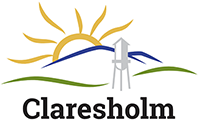Property Taxes Explained - Tax Revenue vs Tax Rate vs Real Tax Cost
Tax revenue vs tax rate vs individual property taxes – Confused??
When talking about taxes, and tax increases, we refer to multiple different things that all sound like the same thing, but are actually very different, which can be confusing. So what are they all? To make sense of it we need to understand how property taxes work.
Property taxes are levied based on a tax rate being applied to the assessed value of a property. The amount of tax needing to be collected is based on the funding needs of the municipality’s approved budget. Council can only control, or make decisions on, the approved budget. They have no control over the assessment value of properties.
Explanation of Different Terms (and of how taxes work):
If Claresholm only had a single property, with an assessed value of $200,000, and the budget approved by Council required $1,000 of tax revenue, the Town would pass a tax rate of 0.005 ($200,000 x 0.005 = $1,000). The next year if the approved budget remained the same, requiring $1,000 of tax revenue, but the assessed value of the one property in Town increased to $250,000, the tax rate for that next year would decrease to 0.004 ($250,000 x 0.004 = $1,000) to still only collect the same $1,000. So in this example the tax revenue increase in the budget is 0% ($1,000 -> $1,000), the assessment growth is 25% (200,000 -> 250,000) and the tax rate decrease is 25% (0.005 -> 0.004). In this case also, the actual tax cost increase for the one property was also 0% ($1,000 -> $1,000) as all the tax revenue is coming from that one property. So to recap, there was a 0% increase in tax revenue (i.e. taxes), but due to a 25% inflation in assessment values there was a 25% reduction in the tax rate, but overall there was a 0% increase in the real tax cost to the property owner – the property owners taxes remained at $1,000.
How can you have a real tax cost increase of less than the tax revenue increase?
The Town can have two different types of assessment growth; real growth and inflationary growth. Real growth is a new development, such as a new house being built or an addition to a house. Inflationary growth is where the assessment value of your house increases (despite no addition or development done to it) based on the market.
For example, if year 1 is the same as the original example above, with only 1 property in Town, but in year 2 a new house is built in Town and the assessment value of the original property stays the same, at $200,000, and the new house has an assessment value of $100,000, we have had total assessment growth of 50% ($200,000 in year 1 -> $300,000 combined assessment value in year 2), but all of this assessment growth came from real growth, there was no inflationary growth.
So if in year two, Council passed a budget with a tax revenue requirement of $1,800, an 80% increase in taxes, or tax revenue, they would pass a tax rate of 0.006 ($300,000 * 0.006). This is a 20% tax rate increase (0.005 -> 0.006), but $600 ($100,000 * .006), or 60%, of this tax revenue increase is coming from real growth (the new property in Town). The real tax cost increase to the existing assessment base, or property 1, is only 20% ($1,000 -> $1,200). So with a 20% increase in the tax rate and therefore a 20% increase in the real tax cost to the existing property, the Town was still able to increase tax revenue 80% due to real growth accounting for 60% of the tax increase.
Why does one person’s taxes increase more than someone else’s?
If we update the original example to say there are 2 properties in Town, instead of 1, each with an assessed value of $100,000, everything in year 1 remains the same, just the actual tax cost for each property is $500 each, to raise the total $1,000 total tax revenue. In year 2, property one’s assessment value remains at $100,000 (0% assessment growth), but property two’s assessment value increases to $150,000 (50% assessment growth. The AVERAGE assessment value growth/inflation is still 25% ($200,000 total assessment value -> $250,000 total assessment value), therefore everything remains the same in year 2 as the original example as well: the tax revenue increase is still 0% ($1,000 - $1,000), the AVERAGE assessment growth is still 25%, the tax rate decrease is still 25% and the AVERAGE real tax cost increase is still 0%, but property one’s real tax cost decreased 20% ($500 -> $400) and property two’s real tax cost increased 20% ($500 -> $600).
